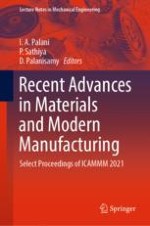This book presents the select proceedings of the fourth International Conference on Advanced Materials and Modern Manufacturing (ICAMMM 2021). It covers broad areas such as advanced mechanical engineering, material science and manufacturing process. Various topics discussed in this book include green manufacturing, green materials, Industry 4.0, additive manufacturing, precision engineering, sustainability, manufacturing operations management and so on. Given its contents, the book will be useful for students, researchers, engineers and professionals working in the area of mechanical engineering and its allied fields.
